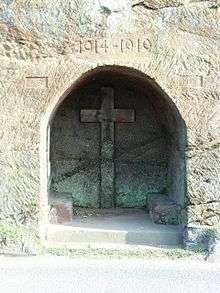Ruyton-XI-Towns
Ruyton-XI-Towns (/ˌraɪtən ɪˈlɛvən taʊnz/[2] "ry-tən eleven towns"), formally Ruyton of the Eleven Towns or simply Ruyton, is a large village and civil parish next to the River Perry in Shropshire, England. It has a population of around 1,500 people, falling to 1,379 at the 2011 Census.
| Ruyton-XI-Towns | |
|---|---|
The Cross in Ruyton-XI-Towns | |
 Ruyton-XI-Towns Location within Shropshire | |
| Population | 1,379 (2011)[1] |
| OS grid reference | SJ393221 |
| Civil parish |
|
| Unitary authority | |
| Ceremonial county | |
| Region | |
| Country | England |
| Sovereign state | United Kingdom |
| Post town | SHREWSBURY |
| Postcode district | SY4 |
| Dialling code | 01939 |
| Police | West Mercia |
| Fire | Shropshire |
| Ambulance | West Midlands |
| UK Parliament | |
The preparatory school Packwood Haugh is north of the village. Footpaths south of the village lead to the sandstone promontory known as The Cliffe. It is still an area of common land, which is the northern section of the Nesscliffe Hill Country Park.[3]
Toponym
The village acquired its unusual name in the twelfth century when a castle was built, and it became the major manor of eleven local townships. The Roman numeral for eleven is included in its name. Some of the eleven ancient townships, mostly situated to the north and west of Ruyton, still survive as hamlets today; although some, like Coton, are just a collection of farm buildings. The eleven were Ruyton, Coton, Shotatton, Shelvock, Eardiston and Wykey, which remain in the parish; and Felton, Haughton, Rednal, Sutton and Tedsmore, now in the parish of West Felton.
History
Lying in the Welsh Marches, Ruyton castle was destroyed in 1202 by the Welsh. It was rebuilt by 1313 but was destroyed again by Owain Glyndŵr. Its ruins stand in the parish churchyard.
In 1308, an attempt was made to refound the town as New Ruyton. It was awarded a charter that briefly gave it the same status as the County of Bristol. However, as raiding continued, the new town declined and lost most of its rights.
Parts of the parish church date from the 1130s.
Notable residents
Corbet Kynaston, Jacobite Tory politician, died at Shelvock, one of his manors, in 1740.[4] Arthur Conan Doyle, while a medical student, worked as an unpaid assistant in the village for a Dr Eliot for four months in 1878, living at Cliffe House.[5] He later recalled Ruyton in his Memories and Recollections (1923) as "not big enough to make one town, far less eleven".[5] Frederic Richardson Murray, later Archdeacon of Belize (1907-1918), was formerly a curate at the parish church.[6] Another medical doctor, William Blair-Bell, founder of the Royal College of Obstetricians and Gynaecologists, lived at Eardiston House in the parish prior to his death in 1936.[7]
War memorial

The parish's WWI war memorial is an 8 ft (2.4 m) carved cave within the sandstone cliff of the Brownhill. Located beside the road leading out of the village towards Baschurch, it is unique to Shropshire. It was conceived by the London architect Stanley Vaughan after a visit to Ruyton, and created by local father-and-son stonemasons Warwick and Len Edwards. The benches within the arch and the cross are all carved out of the rock. The memorial was unveiled in October 1920. The names of fallen from both the First and Second World Wars are listed on plaques within the archway. A third plaque, to an Alfred Rogers, was added in 2007 after he had been omitted from an earlier plaque.[8]
See also
References
- "Civil Parish population 2011". Retrieved 30 November 2015.
- BBC Pronouncing Dictionary of British Names (Oxford, 1971), cited in Wells, John (15 January 2010). "Ruyton how many?". John Wells's phonetic blog. Retrieved 5 March 2010.
- Shropshire Council web page The Cliffe (posterstyle walkers' guide).
- "The Registers of Ruyton in the Eleven Towns", page 25. Transcript published for The Parish Register Society, 1901.
- Brown, Yoland (1988). Ruyton XI Towns, Unusual Name, Unusual History. Brewin Books. pp. 92–93. ISBN 9780947731410.
- Crockford's Clerical Directory 1908, page 1028: published Horace Cox (London) 1908
- Who Was Who, Volume III, 1929-1940. A and C Black. 1947. p. 122.
- Francis, Peter (2013). Shropshire War Memorials, Sites of Remembrance. YouCaxton Publications. p. 159. ISBN 978-1-909644-11-3.
External links
![]()